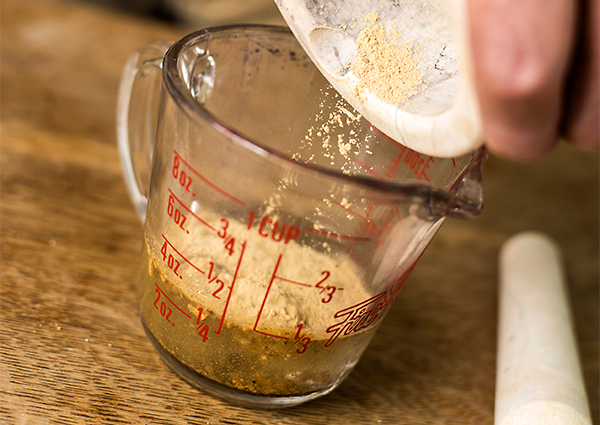The ink of Jane Austen, of Shakespeare, of the Dead Sea Scrolls - this ink is not the quick-to-fade stuff of your pack of Bic pens. The old-fashioned kind should last, on acid-free paper, probably about 500 years, and it's dead easy to make in your home, as people have done for centuries. True, the proportions of home-made iron gall ink are never certain and your ink may start to eat holes in the paper after 50 years - but it still lasts longer than a tweet.
Instructions
-
Bash the gallnuts with a hammer in a section of newspaper or magazine. Newspaper works better than plastic bags, which rip. Pour the fragments into the mortar. The more work you do with the hammer, the less you have to do with the pestle, so break down the shards into large grains.

-
Grind the gallnuts. If you still have some big lumps, drop the pestle on them from a height of three to four centimetres. But don't smash them with the pestle in hand, as this can shatter the mortar. If you can, recruit family and friends to do the grinding while you ready the other ingredients. Try to grind the gallnuts until they are as fine as sugar.

-
Select the vehicle. Water and white wine produce a good ink. Vinegar produces a sheen and will deter insects from your manuscript. Beer works well, but make sure you let it go flat before you begin. (I didn't the first time, and it foamed up like a black milkshake.)

-
Next, take the gum arabic and grind it. This breaks up easily, and you can do it on top of the gallnuts in the pestle.

-
Pour the mixture of gallnuts and gum arabic into your liquid. Stir. The liquid will turn a dusty brown and your audience will be disappointed.

-
Add the bright turquoise ferrous sulphate.

-
Stir. Now the liquid turns a deep black and your audience will gasp in amazement.

-
Write. Your ink will have sediment, so don't use a fountain pen. A dip pen with a calligraphy nib works best. When you start to write, at first nothing may happen. The ink goes on like water. Then as it oxidizes, it starts to turn black or a warm toasty brown, like the Magna Carta or the original Treaty 6.

Ingredients
For a 56-gram bottle of ink
2 gallnuts (see "supplies" below)
7 g (¼ oz.) gum arabic
14 g (½ oz.) ferrous sulphate
56 g (2 oz.) of water, wine, vinegar or flat beer
Tools
-
hammer
-
mortar and pestle
-
measuring cup
-
measuring spoons
-
dip pen
-
acid-free paper
Supplies
I buy my gallnuts (also called oak apples), gum arabic and ferrous sulphate online from Kremer Pigments - although a colleague found gallnuts in the river valley. They are not actually nuts but are formed when wasps plant their larvae in an oak tree.
Speedball dip pens and calligraphy nibs (C-4 or C-6) can be bought at an art supply shop.
Ted Bishop is a Governor General's Award-nominated author and creative non-fiction instructor at the U of A. His book, The Social Life of Ink, took him to Budapest and Buenos Aires in search of the ballpoint pen, to China for traditional ink sticks, and to Uzbekistan, where he encountered the world's oldest Qur'an - the blood-soaked Samarkand Codex.

We at New Trail welcome your comments. Robust debate and criticism are encouraged, provided it is respectful. We reserve the right to reject comments, images or links that attack ethnicity, nationality, religion, gender or sexual orientation; that include offensive language, threats, spam; are fraudulent or defamatory; infringe on copyright or trademarks; and that just generally aren’t very nice. Discussion is monitored and violation of these guidelines will result in comments being disabled.